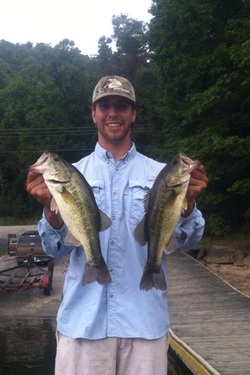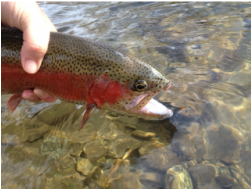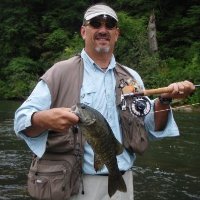 Spring time on mountain lakes and feeder streams/rivers is an exciting time of year for anglers. The large mouth bass are in pre- spawn and spawning mode. Based on water temps and moon phases, this can be some of the most productive time of the year. In the lakes which have walleye and white bass, this is the time when these fish move up the feeder streams to spawn. Fishing the mouths of the feeder rivers/streams where the fish are staging is very productive. The walleye can be caught on Carolina rigs using both worms and lizard patterns. Jigging deer hair jigs tipped with night crawlers is always a popular choice. The White Bass are more aggressive and react better to lipless crank baits, roster tails, even Hopkin spoons. This time of year is great to fish from canoes or sit-on-top kayaks to chase the White Bass up the rivers. Our mountain lakes are often overlooked for fishing, but we have great populations of large mouth, small mouth, walleye, trout, bream, and crappie. Come get you some...
0 Comments
 The WNC Fly Fishing Trail was created in the Winter of 2008-09. The first trail maps were printed and distributed in February of 2009. Since that time over 100,000 maps have been printed and give to anglers across the nation.If anyone would like a copy of the map, or trail information, you can contact AB's Fly Fishing Guide Service at alex@abfish.org or go directly to the trail website. You can also visit www.mountainlovers.com or call 800.962.1911 for a list of accommodations. The trail consists of 15 spots throughout Jackson County and the Cherokee Indian Reservation.This report, and those to follow, will combine some of the small streams, delayed harvest section of the Tuckasegee River, and the trophy section on Raven's Fork in Cherokee. Spring is just around the corner. The past month in Western North Carolina we have had temperatures ranging from below zero to the mid-sixties. That being said, I had a great morning on the Tuck a few days ago with several inches of snow on the ground. As always, the best time to go fishing is "when you can"!!!! Small Streams: As we move into hopefully warmer weather, we will still be seeing darker color flies hatching, usually around mid-morning or late afternoon. March Browns and Red Quills will be a couple of the bugs likely to hatch near the end of the months. Orange and Yellow stimulators are good dry fly choices in the swifter runs. Other good choices are Royal Coachman, Orange Palmer, Yellow Palmer, March Browns, and Red Quills. In deeper pools, you can add a dropper, such as a Copper John Bead Head, Brassie, Zebra Midge, or BH Pheasant Tail nymphs. Dry flys in sizes 12-18 and for the droppers, sizes 18-22. Fishing a nymph under an indicator is another option if the stream is large enough. Popular nymphs this month are: Stick Bait, Secret Weapon, Rubber Leg Prince Delayed Harvest Water: April begins the second month of NC Wildlife stocking of Delayed Harvest waters like the Tuckasegee in Jackson County. The stocking date listed on the NC WIldlife website is April 2, for the Tuck. The recently released trout usually take 24 to 48 hours to become acclimatized to their new environment.The delayed harvest section of the Tuckasegee River is on FIRE!!! Great time of the year to fish delayed harvest waters. Floating the Tuck is a good option when water levels are running high. Remember to always check the generation schedule at www.duke- energy.com and allow for approximately 5 hours from the time of the release until it arrives at the delayed harvest section in Webster. Fishing weighted nymphs under strike indicators is very productive. March Browns and Red Quills are starting to hatch mid-afternoon. Toward the end of the month, black caddis hatches should also take place after lunch. Some of the nymphs include: Rainbow Warriors, Rubber legged Copper Johns, BH Hare's Ear, San Juan or Squirmy worms. Weighted, larger stoneflys are producing very well lately. Big trout can be caught on streamers, but remember to slow your retrieve. Wooly Buggers in Olive, Black, and White are always good options. Varying the length and speed of your retrieve will be most productive. Listen to the fish, if they are taking the streamer more aggressively on shorter faster strips, thats the way you should fish them that day. Trophy Section: Ravens Fork, the trophy section in Cherokee, is still producing large Rainbow as well as some stream raised Browns. Fishing techniques and fly selection is very similar to that used in the delayed harvest section. Fish slowly and thoroughly in the more productive areas. The fish will hold in deeper water early in the day and move to shallower and swifter water as the sun gets higher in the sky. Small nymphs fished on light tippet and longer leaders under an indicator is a good option. As the weather warms look to fish closer to the banks, and especially undercut banks. Using larger, weighted stone flys will become even more productive as the month goes on. If you are comfortable with Czech Nymphing, it can be very productive. As always, please remember a Cherokee trophy section permit as well as a daily permit is required. productive fly patterns of late includes: egg patterns (orange & pink), purple San Juan worms, girdle bugs (black, olive, & brown #6 - #10) zebra midge black & red size 18 - 24 Wishing you Tight Lines & Bent Rods... |
|


 RSS Feed
RSS Feed